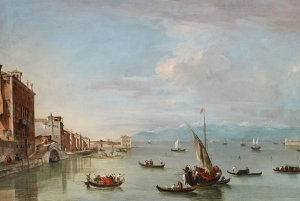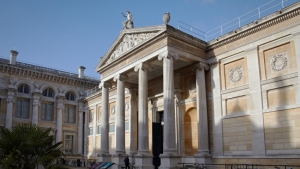|
Displaying items by tag: ashmolean museum
Featuring a hundred drawings from the Uffizi, the Ashmolean, and Christ Church, Oxford, Titian to Canaletto is a groundbreaking exhibition based on new research. Venetian art has long been associated with brilliant colors and free brushwork, but drawing has been written out of its history. This exhibition highlights the significance of drawing as a concept and as a practice in the artistic life of Venice. It reveals the variety of purposes and techniques in drawing from Bellini, Titian and Tintoretto to Tiepolo and Canaletto.
A JMW Turner street scene described as the greatest painting of Oxford will remain in the city after the Ashmolean Museum raised the money to buy it in just four weeks.
The High Street, Oxford, by Turner, was left to the British nation in lieu of inheritance tax, but its value of £3.5m was more than the tax due. That led to a fundraising campaign by the Ashmolean, where the painting has been on loan from a private collection since 1997.
Give or take a few road signs and the clumps of bicycles, the High Street in Oxford is startlingly unchanged from the view, sleepy in dusty golden afternoon light, painted by JMW Turner in 1810. More than two centuries later, the photographer David Fisher managed to capture the scene in a moment of tranquility, miraculously free of buses, bin lorries and groups of Japanese tourists, and without being mown down by a speeding cyclist.
The cramped space in which the artist and poet William Blake produced some of the greatest prints in the history of art will be recreated for an exhibition next month at the Ashmolean Museum in Oxford.
The house, the magnificently named 13 Hercules Buildings, in Lambeth, south London, was demolished in 1918. But the floor plans, made for a Victorian survey of the estate, were recently discovered in the Guildhall library by print-maker and guest curator Michael Phillips.
The director of the Ashmolean Museum, Dr. Alexander Sturgis, has announced that an anonymous UK benefactor has pledged a seven-figure sum of money to match donations to The Ashmolean Fund; a newly established fund to secure the future of Britain’s oldest museum - the news of this donation was released at a press conference in London.
The Ashmolean Fund plans to raise an endowment for the Museum of £50 million. The sum of money will provide at least £2 million annually, which is nearly 20% of its current operating budget, this is designed to support the Ashmolean in perpetuity.
A Renaissance silver-gilt and enamel salt cellar, bequeathed by collector Michael Wellby to the Ashmolean Museum in Oxford, has been identified as Nazi loot. It will thus be returned to the descendants of its pre-WWII owner.
The intricate piece is one of the 500 silverware items—believed to be worth in excess of £10 million—donated to the museum in 2012 by Wellby, a former friend of Professor Timothy Wilson, the museum's Keeper of Western Art.
Hackers have stolen the personal details of nearly 8,000 visitors to Oxford University’s Ashmolean Museum, but the museum is telling people not to worry, reports the Guardian.
The Ashmolean has sent an email to those 7,757 people whose names, addresses, email addresses, and date and time of visit had been accessed by a hacker who attacked the institution’s website. In an email to those affected, after apologizing, the institution assured everyone that no financial information was compromised, so there is only a “small risk” of identity theft. More likely, they can look forward to “some unwanted marketing communications, whether by email, post or telephone.”
A battered pot found in a garage in Cornwall, broken in antiquity and broken again and mended with superglue some 5,500 years later, was treasure – but the scruffy little cardboard label it held is now unlocking a lost history of finds from excavations in Egypt scattered across the world in the late 19th century.
The pot came with an odd family legend that back in the 1950s it was accepted in lieu of a fare by a taxi driver in High Wycombe. Alice Stevenson, curator at the Petrie Museum in London, which among its 80,000 objects has the original excavation records and hundreds of pieces from the same Egyptian cemetery, believes the story is true and may even have identified the mysterious passenger.

The Ashmolean Museum in Oxford, England has acquired ‘Venice: The Fondamenta Nuove with the Lagoon and the Island of San Michele’ by Venetian painter Francesco Guardi. The museum acquired the rarely seen work under the Acceptance in Lieu of Inheritance scheme, which allows inheritance tax debts to be written off in exchange for the acquisition of objects of national importance. The Guardi painting cleared a bill of nearly £2 million. A grant from the Art Fund and contributions in memory of Jo Wilson and the Sir Denis Mahon Charitable Trust helped make up the difference in value, allowing the Ashmolean to acquire the work.
Guardi, who was born into a family of Venetian painters, is best known for his views of the city, which were especially popular with British tourists visiting Italy. Created for a British Grand Tourist, ‘Venice: The Fondamenta Nuove with the Lagoon and the Island of San Michele’ is one of Guardi’s early lagoon views illustrating the northern shore of Venice, the island of San Michele, and distant snow-capped mountains, which are rarely visible from the mainland.
Professor Christopher Brown CBE, Director of the Ashmolean, said, “This painting brings to the Ashmolean a poetic masterpiece in which Francesco Guardi reveals his full artistic potential. As the first major Venetian view-painting to enter the Museum’s collection it makes an inspirational addition to the Britain and Italy Gallery. We are profoundly grateful to the Arts Council, the Art Fund, and other supporters for making this acquisition possible.”

The Ashmolean Museum at Oxford University is currently hosting an exhibition focused on the work of two prominent British artists – Francis Bacon and Henry Moore. The institution has brought together 20 sculptures and 20 drawings by Moore and 20 paintings by Bacon to explore how the vastly different artists handled the treatment of the human figure as well as violence in the 20th century.
Francis Bacon / Henry Moore: Flesh and Bone surveys the distinct visual languages of both artists. While their perspectives differed, each one was inspired by visions of humanity. Professor Christopher Brown CBE, director or the Ashmolean, said, “This is one of the most ambitious and exciting exhibitions we have mounted since we reopened in 2009. It compares the two greatest British artists of the twentieth century, and promises to be both visually thrilling and immensely through-provoking.”
Francis Bacon / Henry Moore: Flesh and Bone, which features works mainly from the 1950s and 1960s, will be on view at the Ashmolean Museum through January 19, 2014.
|
|
|
|
|